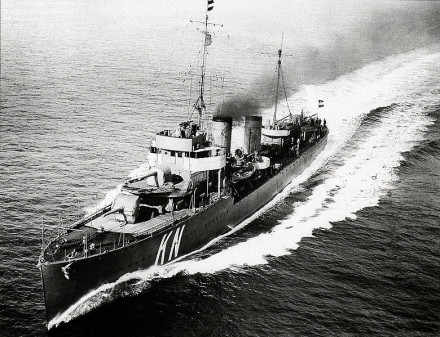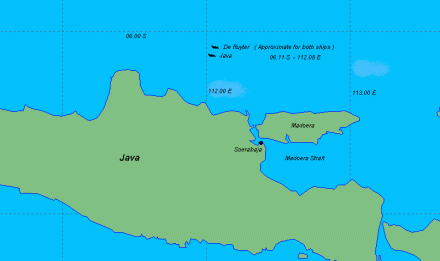History
Construction
In 1925, the keel was laid for the Royal Netherlands Navy destroyer Hr.Ms. Kortenaer at Burgerhout dockyard in Rotterdam. Three years later, the ship entered service in the former Dutch East Indies.
World War II
In early February of 1942, the Kortenaer was grouped with an attack squadron led by rear admiral Karel Doorman, which was to thwart the invading Japanese forces at Bali. However, the ship stranded on a sandbar and was unable to participate in the (failed) attempt.
Battle of the Java Sea
On February 27, 1942 the Kortenaer saw its first combat action during the Battle of the Java Sea, which would seal the fate of the Dutch East Indies. While sailing off the Javanese north coast, the American-British-Dutch-Australian (ABDA) Joint Striking Force under Doorman, was surprised by two Japanese heavy cruisers, Nachi and Haguro.
Soon, the Allied forces found themselves under heavy fire from the high caliber Japanese guns. Doorman, however, managed to get his ships in range to return fire. Even though both sides were not very successful with their gunnery and torpedos during this first phase of the battle, the Kortenaer was hit by a torpedo that had been fired by the Haguro. The Dutch ship sank with the loss of 60 crew members. 113 survivors were rescued by the HMS Encounter. Later that day the Allied ships the HMS Exeter, Hr. Ms. De Ruyter, Hr. Ms. Java and HMS Jupiter were also sunk by the Japanese. The battle factually eradicated Dutch presence in South-East Asian waters and marked the end to the Dutch colonial age.
Description
Yard: Burgerhout's Machinefabriek en Scheepswerf NV, Rotterdam
Armament:
4 x 1 120 mm Bofors No. 5 guns
2 x 75 mm guns
4 x .50 inch Browning machine guns
The ship was laid down on August 24th, 1925 and launched on April 24th, 1927. It was commissioned on September 3rd, 1928.

| Master | R. Crommelin |
|---|---|
| People on board | 151 |
| Power | 31000 hp |
| Speed | 34 knots ~ 39 mph (63 km/h) |
| Length | 321 ¾ feet (98.1 m) |
| Width | 31 ¼ feet (9.5 m) |
| Displacement | 1316 ton |
Status
Discovery
The wreck of the Java is designated as 'historic shipwreck on official nautical charts. During an expedition led by Kevin Denlay in 2004, the wrecks of the Java and the Kortenaer were discovered off Bawean island, using side-scan sonar and diving inspections. The stern section of Kortenaer was found lying on its starboard side in good condition. One set of triple torpedo tubes were also visible trapped in large amounts of fishing nets that were draped over the wreckage. This provided the evidence for the wreck's identification, as no other warship lost in the area had triple torpedo tubes. No pictures of the wreck are available, due to the extremely poor visibility under water.
Salvage
In 2016 it was discovered that the wrecks of the De Ruyter and Java, and much of the Kortenaer had disappeared from the seabed, although their imprints on the ocean floor remained. During a meeting on November 23, 2016, President Widodo of Indonesia and Prime Minister Rutte of the Netherlands agreed that the countries would work together to determine what had happened and to preserve their maritime heritage in the future. A three-tracked approach was agreed upon by both governments:
Verification of the disappearance;
Appreciation of what had happened; and
Future cooperation to manage remaining maritime cultural heritage.
More information on this joint Dutch-Indonesian investigation can be found in the publications under references and here.

References
- Report of the Dutch Shipwrecks in the Java Sea.
- M.R. Manders/R.W. de Hoop/S. Adhityatama/W.A. Barten/B. Budi Utomo/O. Dwiyana/A. Kusno/J. Rechar & Z. Tahir (2017).
Joint Verification of the location and condition of Hr.Ms. De Ruyter, Java and Kortenaer. - RCE (2018).
Public Summary Report of the Joint Expert Meeting on the Appreciation (track II) of the Dutch Shipwrecks in the Java Sea. - M.R. Manders & R.W. de Hoop (2018).
Battle of the Java Sea: Past and Present Conflicts. - M.R. Manders, R.W. de Hoop & Shinatria Adhityatama (2019).
Field Assessment Java Sea Survey of three Dutch WWII naval wreck sites in the Java Sea, Progress Report. - S. Lovegrove/R.W. de Hoop/S. Adhityatama (2020).
Good practice: international collaboration on shared difficult heritage.
Sharing Heritage Expertise nr. 13. - M.R. Manders/R.W. de Hoop/S. Adhityatama/D.S. Bismoko/P. Syofiadisna & D. Haryanto (2020).
Battle of the Java Sea: One Event, Multiple Sites, Values and Views.
Journal of Maritime Archaeology 2021. - Hr.Ms. Kortenaer.
- The Battle of the Java Sea.
- Rear-admiral Karel Doorman.
- Australian War memorial.